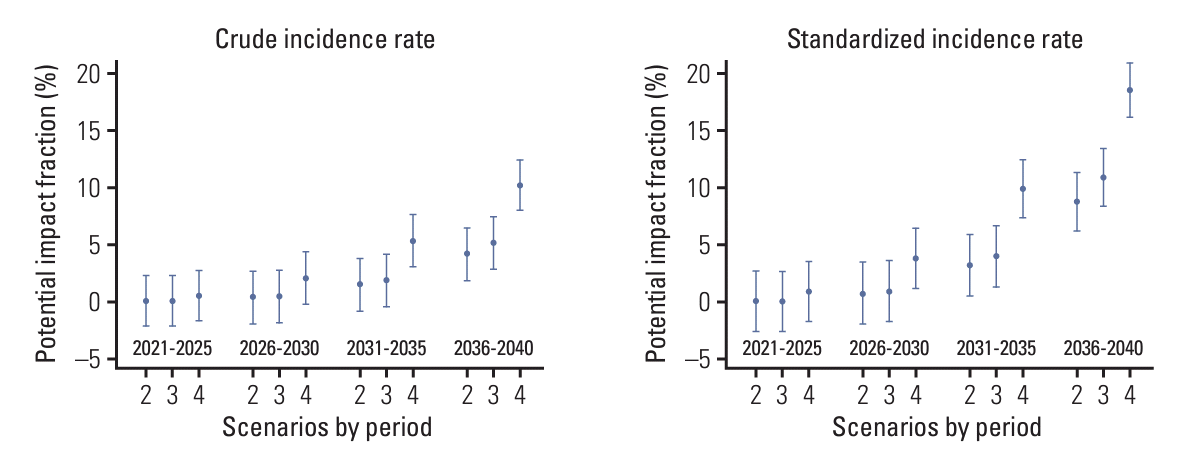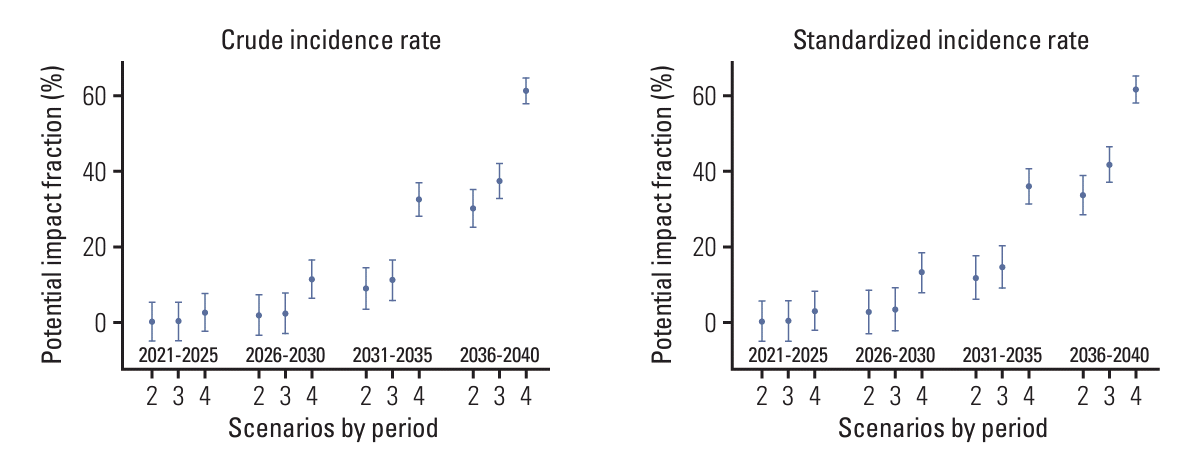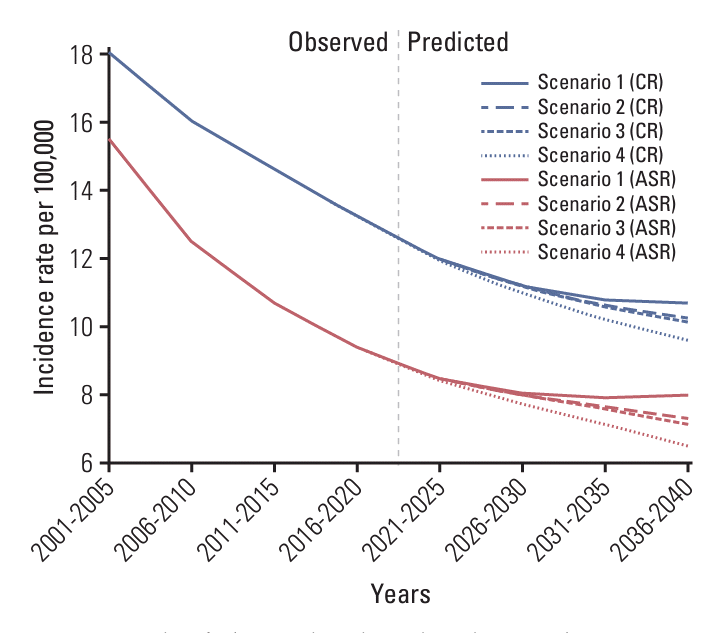2. Sung H, Ferlay J, Siegel RL, Laversanne M, Soerjomataram I, Jemal A, et al. Global cancer statistics 2020: GLOBOCAN estimates of incidence and mortality worldwide for 36 cancers in 185 countries. CA Cancer J Clin. 2021; 71:209–49.

5. Castellsague X, Bosch FX, Munoz N, Meijer CJ, Shah KV, de Sanjose S, et al. Male circumcision, penile human papillomavirus infection, and cervical cancer in female partners. N Engl J Med. 2002; 346:1105–12.

6. Bosch FX, Manos MM, Munoz N, Sherman M, Jansen AM, Peto J, et al. Prevalence of human papillomavirus in cervical cancer: a worldwide perspective. International biological study on cervical cancer (IBSCC) Study Group. J Natl Cancer Inst. 1995; 87:796–802.

7. Walboomers JM, Jacobs MV, Manos MM, Bosch FX, Kummer JA, Shah KV, et al. Human papillomavirus is a necessary cause of invasive cervical cancer worldwide. J Pathol. 1999; 189:12–9.

8. Stewart BW, Wild CP. World cancer report 2014. Chapter 5.12. Cancers of the female reproductive organ. Geneva: World Health Organization;2014. p. 465–82.
9. Kessler TA. Cervical cancer: prevention and early detection. Semin Oncol Nurs. 2017; 33:172–83.
10. Munoz N, Castellsague X, Berrington de Gonzalez A, Gissmann L. Chapter 1: HPV in the etiology of human cancer. Vaccine. 2006; 24 Suppl 3:S3/1–10.

12. World Health Organization. Electronic address swi. Human papillomavirus vaccines: WHO position paper, May 2017-Recommendations. Vaccine. 2017; 35:5753–5.
15. Petrosky E, Bocchini JA Jr, Hariri S, Chesson H, Curtis CR, Saraiya M, et al. Use of 9-valent human papillomavirus (HPV) vaccine: updated HPV vaccination recommendations of the advisory committee on immunization practices. MMWR Morb Mortal Wkly Rep. 2015; 64:300–4.
16. Meeting of the Strategic Advisory Group of Experts on immunization, April 2014: conclusions and recommendations. Wkly Epidemiol Rec. 2014; 89:221–36.
17. Kreimer AR, Sampson JN, Porras C, Schiller JT, Kemp T, Herrero R, et al. Evaluation of durability of a single dose of the bivalent HPV vaccine: the CVT trial. J Natl Cancer Inst. 2020; 112:1038–46.

18. Basu P, Malvi SG, Joshi S, Bhatla N, Muwonge R, Lucas E, et al. Vaccine efficacy against persistent human papillomavirus (HPV) 16/18 infection at 10 years after one, two, and three doses of quadrivalent HPV vaccine in girls in India: a multicentre, prospective, cohort study. Lancet Oncol. 2021; 22:1518–29.

19. Barnabas RV, Brown ER, Onono MA, Bukusi EA, Njoroge B, Winer RL, et al. Efficacy of single-dose HPV vaccination among young African women. NEJM Evid. 2022; 1:EVIDoa2100056.
20. World Health Organization. Meeting of the strategic advisory group of experts on immunization, April 2022: conclusions and recommendations. Wkly Epidemiol Rec. 2022; 97:261–76.
21. Shin HR, Won YJ, Jung KW, Kong HJ, Yim SH, Lee JK, et al. Nationwide cancer incidence in Korea, 1999~2001; first result using the national cancer incidence database. Cancer Res Treat. 2005; 37:325–31.

22. Oh CM, Won YJ, Jung KW, Kong HJ, Cho H, Lee JK, et al. Cancer statistics in Korea: incidence, mortality, survival, and prevalence in 2013. Cancer Res Treat. 2016; 48:436–50.

23. Berman TA, Schiller JT. Human papillomavirus in cervical cancer and oropharyngeal cancer: one cause, two diseases. Cancer. 2017; 123:2219–29.

24. Kim YT, Serrano B, Lee JK, Lee H, Lee SW, Freeman C, et al. Burden of Human papillomavirus (HPV)-related disease and potential impact of HPV vaccines in the Republic of Korea. Papillomavirus Res. 2019; 7:26–42.

25. Arbyn M, Xu L. Efficacy and safety of prophylactic HPV vaccines. A Cochrane review of randomized trials. Expert Rev Vaccines. 2018; 17:1085–91.

27. Antoni S, Soerjomataram I, Moller B, Bray F, Ferlay J. An assessment of GLOBOCAN methods for deriving national estimates of cancer incidence. Bull World Health Organ. 2016; 94:174–84.
28. Ahmad OB, Boschi-Pinto C, Lopez AD, Murray CJ, Lozano R, Inoue M. Age standardization of rates: a new WHO standard. GPE Discussion Paper Series, No. 31. EIP/GPE/EBD. Geneva: World Health Organization;2001.
29. Hildebrandt M, Bender R, Gehrmann U, Blettner M. Calculating confidence intervals for impact numbers. BMC Med Res Methodol. 2006; 6:32.

30. Olsen CM, Wilson LF, Green AC, Biswas N, Loyalka J, Whiteman DC. How many melanomas might be prevented if more people applied sunscreen regularly? Br J Dermatol. 2018; 178:140–7.

31. Ren X, Qiu L, Ke W, Zou H, Liu A, Wu T. Awareness and acceptance of HPV vaccination for condyloma acuminata among men who have sex with men in China. Hum Vaccin Immunother. 2022; 18:2115267.

33. Gertig DM, Brotherton JM, Budd AC, Drennan K, Chappell G, Saville AM. Impact of a population-based HPV vaccination program on cervical abnormalities: a data linkage study. BMC Med. 2013; 11:227.

34. Powell SE, Hariri S, Steinau M, Bauer HM, Bennett NM, Bloch KC, et al. Impact of human papillomavirus (HPV) vaccination on HPV 16/18-related prevalence in precancerous cervical lesions. Vaccine. 2012; 31:109–13.

35. Cuschieri K, Kavanagh K, Cameron R, Bhatia R, Pollock KG. The massive decline of clinically relevant high-risk human papillomavirus (HR-HPV) infection in Scotland. In : Microbiology Society Annual Conference; 2017 Apr 3-6; Edinburgh, UK.
36. Tabrizi SN, Brotherton JM, Kaldor JM, Skinner SR, Liu B, Bateson D, et al. Assessment of herd immunity and cross-protection after a human papillomavirus vaccination programme in Australia: a repeat cross-sectional study. Lancet Infect Dis. 2014; 14:958–66.

37. Ekwunife OI, O’Mahony JF, Gerber Grote A, Mosch C, Paeck T, Lhachimi SK. Challenges in cost-effectiveness analysis modelling of HPV vaccines in low- and middle-income countries: a systematic review and practice recommendations. Pharmacoeconomics. 2017; 35:65–82.

38. World Health Organization (WHO). Global strategy to accelerate the elimination of cervical cancer as a public health problem [Internet]. Geneva: World Health Organization;c2020. [cited 2023 Apr 4]. Available from:
https://www.who.int/publications/i/item/9789240014107.
39. Brotherton JM, Tabrizi SN, Phillips S, Pyman J, Cornall AM, Lambie N, et al. Looking beyond human papillomavirus (HPV) genotype 16 and 18: defining HPV genotype distribution in cervical cancers in Australia prior to vaccination. Int J Cancer. 2017; 141:1576–84.

40. Wnukowski-Mtonga P, Jayasinghe S, Chiu C, Macartney K, Brotherton J, Donovan B, et al. Scientific evidence supporting recommendations on the use of the 9-valent HPV vaccine in a 2-dose vaccine schedule in Australia. Commun Dis Intell (2018). 2020; 44:1–12.

41. Phillips A, Patel C, Pillsbury A, Brotherton J, Macartney K. Safety of human papillomavirus vaccines: an updated review. Drug Saf. 2018; 41:329–46.

42. Garland SM. The Australian experience with the human papillomavirus vaccine. Clin Ther. 2014; 36:17–23.

43. Sinka K, Kavanagh K, Gordon R, Love J, Potts A, Donaghy M, et al. Achieving high and equitable coverage of adolescent HPV vaccine in Scotland. J Epidemiol Community Health. 2014; 68:57–63.

44. Chido-Amajuoyi OG, Talluri R, Wonodi C, Shete S. Trends in HPV vaccination initiation and completion within ages 9-12 years: 2008-2018. Pediatrics. 2021; 147:e2020012765.
45. Toh ZQ, Russell FM, Reyburn R, Fong J, Tuivaga E, Ratu T, et al. Sustained antibody responses 6 years following 1, 2, or 3 doses of quadrivalent human papillomavirus (HPV) vaccine in adolescent Fijian girls, and subsequent responses to a single dose of bivalent HPV vaccine: a prospective cohort study. Clin Infect Dis. 2017; 64:852–9.
46. Lee EH, Um TH, Chi HS, Hong YJ, Cha YJ. Prevalence and distribution of human papillomavirus infection in Korean women as determined by restriction fragment mass polymorphism assay. J Korean Med Sci. 2012; 27:1091–7.

47. Lee SY, Lee JE, Gi MG, Kang C. An overview of immunization and efficacy of human papillomavirus vaccines. Public Health Wkly Rep. 2014; 7:1162–6.






 PDF
PDF Citation
Citation Print
Print




 XML Download
XML Download